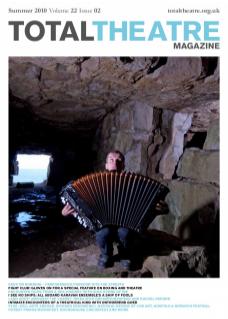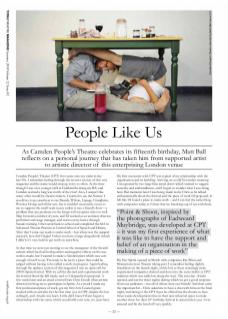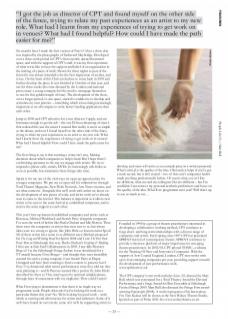Camden People’s Theatre (CPT) first came onto my radar in the late 90s. I remember leafing through the reviews section of this very magazine and the name would crop up every so often. At the time though I was a lot younger (still at Goldsmiths doing my BA) and Camden seemed a long way north of the river! Also, I suspect like many other would-be theatre makers, I wanted to see the Names: I would try to go anywhere to see Bausch, Wilson, Lepage, Complicite, Wooster Group and all the rest, but it wouldn’t necessarily occur to me to support the small-scale sector unless it was a friend’s show – a problem that any producer on the fringe will recognise only too well. Skip forward a number of years, and I’d worked as an assistant director, performer and stage manager, and worn out my knees through Suzuki training. I then went back to school and completed the MA in Advanced Theatre Practice at Central School of Speech and Drama. After that I came out ready to make work – but where was the support network, how did I begin? Unless you have a large chequebook (which I didn’t) it’s very hard to get work on anywhere.
At that time we were just starting to see the emergence of the Scratch culture which has had both positive and negative effects on the way work is made, but I wanted to make a finished piece which was sure enough of itself to say ‘I’m ready to be seen’; a piece that could be judged without having to be called a work-in-progress. Again leafing through the updates section of this magazine I saw an open call for 2004’s Sprint festival. With its call for devised and experimental work the festival fitted the bill nicely, and so I despatched a proposal. A few weeks later and an email arrived from Chris Goode (then artistic director) inviting me to participate in Sprint. As a result I made my first professional piece of work, got my first Arts Council grant, worked with an aerialist for the first time (yes in CPT, despite the low ceilings!), and Ariadne was born. Little did I know I’d just begun a relationship with the venue which would still exist now, six years later.
My first encounter with CPT was typical of my relationship with the organisation and its building. Arriving on a cold November morning I was greeted by two large blue metal doors which seemed to suggest austerity and unfriendliness, and I began to wonder what I was doing here. But moments later I was being made tea by Chris as he talked enthusiastically about the festival and the piece of work I’d proposed. It felt like I’d found a place to make work – and I can feel the same thing with companies today as I share that ice-breaking cup of tea with them.
My first Sprint opened in March with companies like Brian and Momentum (now Tmesis) taking part. I remember feeling slightly fraudulent on the launch night, a little lost as these seemingly more experienced companies chatted and dove into the curry buffet (a CPT tradition which was sadly lost along the way). The next day Ariadne opened, and ran for three nights during which we got a good response from our audiences – not all of whom were our friends! And then came the important bit – Chris asked me to have a chat with him on the final night, and sitting in the CPT foyer he offered me the chance to have three weeks development time in their new rehearsal space to make another show for their 10th birthday festival in autumn that year. I was amazed and bit the hand off very quickly.
Six months later I made the first version of Point & Shoot, a show that was inspired by the photographs of Eadweard Muybridge. Developed over a three-week period in CPT’s then recently opened basement space, and with the support of CPT’s staff, it was my first experience of what it was like to have the support and belief of an organisation in the making of a piece of work. Shown for three nights as part of the festival it was always intended to be the first impression of an idea, and it was. On the basis of this Chris invited me to come back in 2005 and further develop the piece. It was finished in October of that year, and ran for three weeks (the time dictated by the London and national press; many a young company feel the need to mortgage themselves to run for this golden length of time). The development of the show, over a longer period, in one space, started to enable me to develop and articulate my own practice – something which is becoming increasingly important as we all compete to write better funding applications than each other.
Jump to 2006 and CPT advertise for a new director. I apply, and am fortunate enough to get the job – the one I’d been dreaming of since I first realised this was the career I wanted. But reality is never as simple as the dream, and now I found myself on the other side of the fence, trying to relate my past experiences as an artist to my new role. What had I learnt from my experiences of trying to get work on in venues? What had I found helpful? How could I have made the path easier for me?
The first thing to say is that running a venue isn’t easy. Making decisions about which companies to help is hard. But I hope there’s a refreshing openness to the way we engage with artists. We try to respond to phone calls, emails, DVDs (or increasingly web-links) as soon as possible, but sometimes these things take time.
Sprint is for me one of the vital ways we open up opportunities for younger companies. We put out an open call for submissions through Total Theatre Magazine, New Work Network, Arts News etcetera, and see what comes in. Alongside this we’ll work with artists we know on the development of new pieces of work, and invite work we’ve already seen to come to the festival. This balance is important as it allows new artists to be seen in the same festival as established companies, and to receive the same support as each other.
This year’s line-up featured established companies and artists such as Rotozaza, Michael Pinchbeck and Search Party alongside companies I’ve seen the work of before like Sheila Ghelani and Idle Motion. Then there were the companies or artists that were new to us, but whose ideas were too strong to ignore, like John Hicks or Inconvenient Spoof. All of these artists have come to us different ways: Michael proposed his The Long and Winding Road for Sprint 2008 and I saw The Post Show Party Show in Edinburgh this year. Sheila Ghelani’s Grafting & Budding I first saw at East End Collaborations in 2005. I saw Idle Motion’s Borges & I at the Edinburgh Fringe (before it was shortlisted for a TT award) because I love Borges – and thought they were incredibly assured for such a young company. I saw Search Party at Depot Untapped and have been wanting to find a context to present Search Party Vs (a durational table tennis performance) since they told me they were planning it – and St Pancras seemed like a perfect fit. John Hicks described his show as ‘One man’s quest for spiritual enlightenment, through feats of amazement with toy elephants.’ How could I resist?
What I’m trying to demonstrate is that there is no single way we programme work. People often ask if we’re looking for work on a particular theme this year? No. We’re looking for good work – work which is exciting and adventurous for artists and audiences. Some of it we’ll have found on our travels, some of it we’ll be supporting artists to develop, and some will arrive as an unmade piece in a written proposal. What’s critical is the quality of the idea. Obviously it helps if you’ve got a track record, but it isn’t crucial – two of this year’s companies hadn’t made anything professionally before. Of course what you or I like are different, what me and my colleagues like are different – but I’m confident I can remove my personal aesthetic preferences and focus on the quality of the idea. What’ll we programme next year? Well that’s up to you as much as me…
Founded in 1994 by a group of theatre practitioners interested in developing a collaborative working method, CPT continues to forge short- and long-term relationships with a diverse range of companies and artists. Each spring since 1997 CPT has presented SPRINT festival of contemporary theatre. SPRINT continues to provide a showcase platform of major importance for emerging theatre practitioners. In 2002/03, CPT piloted TONIC, a scheme for the Training Of New and Innovative Companies. With the support of Arts Council England, London, CPT now works with up to four emerging companies per year, providing support towards the development of new performance work. www.cptheatre.co.uk
The CPT company’s own work includes Icarus 2.0, directed by Matt Ball, which was nominated for a Total Theatre Award for Devised Performance and a Stage Award for Best Ensemble at Edinburgh Festival Fringe 2009. Matt Ball also directed the Fringe First awardwinning Paperweight (2008). A work-in-progress of his latest piece, Free Time Radical, will be shown at the New Wolsey Theatre Studio, Ipswich as part of Pulse 2010. See www.wolseytheatre.co.uk


